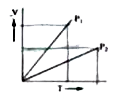An air bubble comes from the bottom to the surface of a lake of depth 2.5 m. The surface temperature of the lake is 40∘C. The diameter of the bubble at the bottom and at the surface are 3.6 mm and 4 mm respectively. Find the temperature of the lake at the bottom.Solution in Telugu
5.3∘C
12.5∘C
20.3∘C
30.3∘C
The correct Answer is:B
Step by step video, text & image solution for An air bubble comes from the bottom to the surface of a lake of depth 2.5 m. The surface temperature of the lake is 40^(@)C. The diameter of the bubble at the bottom and at the surface are 3.6 mm and 4 mm respectively. Find the temperature of the lake at the bottom. by Physics experts to help you in doubts & scoring excellent marks in Class 11 exams.
Updated on:21/07/2023Topper's Solved these Questions
- THERMAL PROPERTIES OF MATTERBOOK - AAKASH SERIESCHAPTER - THERMAL PROPERTIES OF MATTEREXERCISE - EXPANSION OF GASES (LECTURE SHEET) Straight Objective Type Questions (Kinetic theory of gases)
5 Videos
- THERMAL PROPERTIES OF MATTERBOOK - AAKASH SERIESCHAPTER - THERMAL PROPERTIES OF MATTEREXERCISE - EXPANSION OF GASES (LECTURE SHEET) More than One correct answer Type Questions
5 Videos
- THERMAL PROPERTIES OF MATTERBOOK - AAKASH SERIESCHAPTER - THERMAL PROPERTIES OF MATTEREXERCISE - EXPANSION OF GASES (LECTURE SHEET) Straight Objective Type Questions (Ideal Gas equation - applications)
10 Videos
- SYSTEM OF PARTICLES AND ROTATIONAL MOTIONBOOK - AAKASH SERIESCHAPTER - SYSTEM OF PARTICLES AND ROTATIONAL MOTIONEXERCISE - PRACTICE EXERCISE
99 Videos
- THERMODYNAMICSBOOK - AAKASH SERIESCHAPTER - THERMODYNAMICSEXERCISE - EXERCISE - 3
33 Videos
Similar Questions
Two thermally insulated vessels 1 and 2 are filled with air at temperature (T1,T2), volume (V1,V2) and pressure (P1,P2) respectively. If the valve joining the two vessels is opened, the temperature inside the vessel at equilibrium will be
View SolutionLet ¯υ,υrmsandυp respectively denote the mean speed, root mean square speed and most probable speed of the molecules in an ideal monatomic gas at absolute temperature T. The mass of a molecule is m. Then:
View SolutionFor an ideal gas V-T curves as constant pressures P1&P2 are shown in figure - from the figure

View SolutionThe centre of mass of two particles with masses 2kg and 6 kg located at (1,1,1), (2,2,1) respectively has the coordinates
View SolutionA bullet of mass 10×10−3 moving with a speed of 20ms−1 hits an ice block (0∘C) of 990g kept at rest on a frictionless floor and gets embedded in it. If ice takes 50% of K.E, the amount of ice melted (in grams) approximately is (J=4.2J/cal) (latent heat of ice=80cal/g)
View SolutionAn air bubble starts rising from the bottom of a lake. Its diameter is 3.6mm at the bottom and 4mm at the surface. The depth of the lake is 250cm and the temperature at the surface is 40∘C. What is the temperature at the bottom of the lake? Given atmospheric pressure = 76cmofHgandg=980cm/s2.
View SolutionSurface of the lake is at 2∘C and depth of the lake is 20m find the temperature of the bottom of the lake
View SolutionSurface of the lake is at 2”∘C. The temperature of the bottom of the lake is
View SolutionAn air bubble starts rising from the bottom of a lake. Its diameter is 3.6mm at the bottom and 4mm at the surface. The depth of the lake is 250cm and the temperature at the surface is 40∘C. What is the temperature at the bottom of the lake? Given atmospheric pressure = 76cmofHgandg=980cm/s2.
View SolutionAn air bubble starts rising from the bottom of a lake. Its diameter is 3.6 mm at the bottom and 4mm at the surface. The depth of the lake is 250 cm and the temperature at the surface is 40^@C . The atmospheric pressure is 76 cm of Hg and g=980 cm.s^-2 . What is the pressure at the bottom of the lake?
View SolutionAn air bubble starts rising from the bottom of a lake. Its diameter is 3.6 mm at the bottom and 4mm at the surface. The depth of the lake is 250 cm and the temperature at the surface is 40^@C . The atmospheric pressure is 76 cm of Hg and g=980 cm.s^-2 . What is the temperature at the bottom of the lake?
View SolutionAn air bubble of diameter 1cm is formed at a depth of 238ft in a lake. What will be the diameter (in cm) of the bubble when it reaches the free surface? Given that the temperature from top to bottom in the lake is same and the height of a water barometer is 34 ft.
View SolutionThe temperature at the bottom of a 40 m deap lake is 12^(@)C and that at the surface is 35^(@)C . An air bubble of volume 1.0cm^(3) rises from the bottom to the surface. Find its volume. (atmospheric pressure = 10 m of water)
View SolutionRead the following paragraph carefully and answer the questions. An air bubble is rising from the bottom of a lake. The diameter of the bubble is 3.6 mm at the bottom of the lake and 4 mm at the surface, the depth of the lake is 250 cm and the surface temperature is 40 ° C. Atmospheric pressure = 76 cmHg and g = 980 cm/s^2 . What is the pressure at the bottom of the lake?
View SolutionRead the following paragraph carefully and answer the questions. An air bubble is rising from the bottom of a lake. The diameter of the bubble is 3.6 mm at the bottom of the lake and 4 mm at the surface, the depth of the lake is 250 cm and the surface temperature is 40 ° C. Atmospheric pressure = 76 cmHg and g = 980 cm/s^2 . What is the temperature of the water at the bottom of the lake?
View Solution
